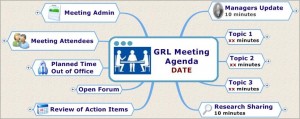MindJet Diary: From Net Meetings to Map Meetings
Global Teams, Idea Mapping, Idea Mapping Example, Multi-Cultural Teams, Remote Collaboration, Virtual Teams, Visualization April 4th, 2009We are a global team. For years, we’ve depended on MeetingPlace or NetMeeting as standard communication tools enabling us to connect and work together in a virtual space during our weekly team meetings. In the past few weeks, we are taking our meetings to the next level with the help of the idea mapping method and MindJet.
As a collaboration tool, remote meetings have many disadvantages. The risk of misunderstanding increases when you have more than a dozen of people from different countries attending a call. You cannot see your colleagues (you can, of course, with video conferencing technology, but we are not there yet). Right there, you can miss a lot in terms of subtle communication including body language, facial expression, mood, worries, etc. Even with well established and time-proven rules of meeting engagement that we’ve developed and implemented over the last 4 years, team collaboration and engagement during a traditional teleconference suffers the limitations that come with that medium. Add to that the routine nature of the meetings and we can understand why some meetings are less than energizing and simply boring. These are a few reasons why we’ve decided to enhance our meetings by using real time collaborative mapping as an alternative to net meetings.
We had a lot of fun creating a meeting agenda map template (scroll down to the March 7 post for details). The map contest winner was Safique Hazarika, our Mumbai manager. His map (see below) is now being officially used for our weekly staff meetings. We all were very excited during the first map meeting and everybody was engaged in contributing comments, adding notes and – to my surprise – decisively rearranging branches and taking ownership of the map. It was fun to see small icons of people with corresponding names moving around the map IN REAL TIME. Even if you cannot see faces, there is an increased perception of personal presence that you get using this tool. There is also a sense of stronger connection between team members. In the following weeks, we’ve taken a few steps to make our map meetings more efficient (we all enjoyed that creative chaos of the first meetings but there is work to be done!). Each week’s agenda items are added to that week’s map by team members prior to a meeting, with as many details as needed, including document attachments. This material can be reviewed in advance of the meeting. To avoid multiplication of notes taking during a meeting, we’ve decided to designate a single person to add notes to the map as discussions take place. Each person can add his or her notes if he or she feels that not all important points were captured by a designated notes taker. We want the process to be flexible but not too distractive. We keep meeting maps in the MindJet Connect folder that everyone can access at any time. It is hard to say at this early stage whether or not real time map meetings will be a much better alternative to traditional net meetings in terms of increased effectiveness and better results, but we’ve already seen a few benefits including:
-
increased team members’ engagement
-
heightened sense of connection with colleagues
-
breaking routine – we feel energized and have fun
These are intangibles that are hard, if not impossible, to measure. But we all know how important they are for building stronger teams.

![[blinklist]](http://powermapping.ideamappingsuccess.com/IdeaMappingBlogs/wp-content/plugins/bookmarkify/blinklist.png)
![[BlogMarks]](http://powermapping.ideamappingsuccess.com/IdeaMappingBlogs/wp-content/plugins/bookmarkify/blogmarks.png)
![[Blogsvine]](http://powermapping.ideamappingsuccess.com/IdeaMappingBlogs/wp-content/plugins/bookmarkify/blogsvine.png)
![[del.icio.us]](http://powermapping.ideamappingsuccess.com/IdeaMappingBlogs/wp-content/plugins/bookmarkify/delicious.png)
![[Digg]](http://powermapping.ideamappingsuccess.com/IdeaMappingBlogs/wp-content/plugins/bookmarkify/digg.png)
![[diigo]](http://powermapping.ideamappingsuccess.com/IdeaMappingBlogs/wp-content/plugins/bookmarkify/diigo.png)
![[Facebook]](http://powermapping.ideamappingsuccess.com/IdeaMappingBlogs/wp-content/plugins/bookmarkify/facebook.png)
![[Jeqq]](http://powermapping.ideamappingsuccess.com/IdeaMappingBlogs/wp-content/plugins/bookmarkify/jeqq.png)
![[Ma.gnolia]](http://powermapping.ideamappingsuccess.com/IdeaMappingBlogs/wp-content/plugins/bookmarkify/magnolia.png)
![[Mister Wong]](http://powermapping.ideamappingsuccess.com/IdeaMappingBlogs/wp-content/plugins/bookmarkify/misterwong.png)
![[Netvouz]](http://powermapping.ideamappingsuccess.com/IdeaMappingBlogs/wp-content/plugins/bookmarkify/netvouz.png)
![[Newsvine]](http://powermapping.ideamappingsuccess.com/IdeaMappingBlogs/wp-content/plugins/bookmarkify/newsvine.png)
![[Propeller]](http://powermapping.ideamappingsuccess.com/IdeaMappingBlogs/wp-content/plugins/bookmarkify/propeller.png)
![[Reddit]](http://powermapping.ideamappingsuccess.com/IdeaMappingBlogs/wp-content/plugins/bookmarkify/reddit.png)
![[Slashdot]](http://powermapping.ideamappingsuccess.com/IdeaMappingBlogs/wp-content/plugins/bookmarkify/slashdot.png)
![[Sphinn]](http://powermapping.ideamappingsuccess.com/IdeaMappingBlogs/wp-content/plugins/bookmarkify/sphinn.png)
![[StumbleUpon]](http://powermapping.ideamappingsuccess.com/IdeaMappingBlogs/wp-content/plugins/bookmarkify/stumbleupon.png)
![[Technorati]](http://powermapping.ideamappingsuccess.com/IdeaMappingBlogs/wp-content/plugins/bookmarkify/technorati.png)
![[Twitter]](http://powermapping.ideamappingsuccess.com/IdeaMappingBlogs/wp-content/plugins/bookmarkify/twitter.png)
![[Email]](http://powermapping.ideamappingsuccess.com/IdeaMappingBlogs/wp-content/plugins/bookmarkify/email.png)